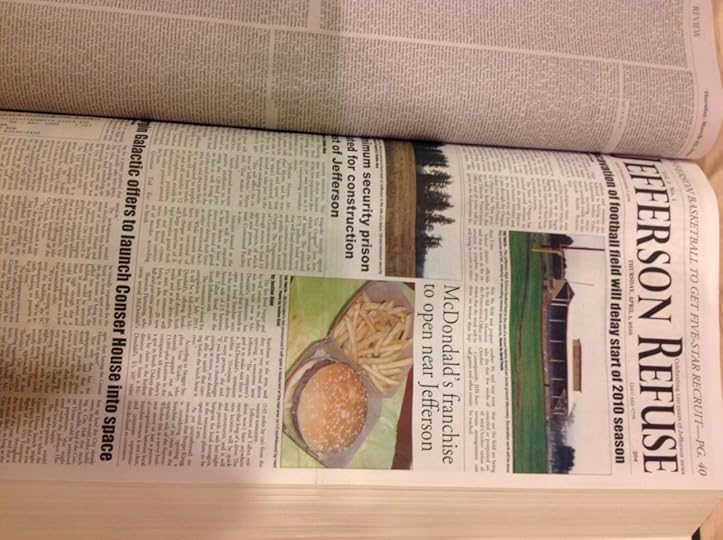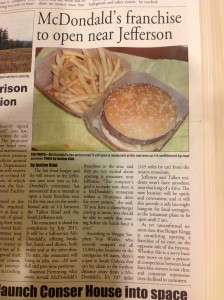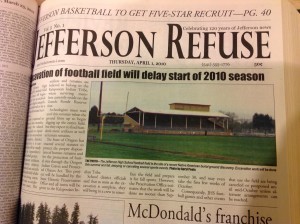April Fools’ Day Articles In 10 Easy Steps

From 1998-2012, I owned one or more weekly newspapers. As publisher, my number one goal was to provide the communities we served with fair, accurate news. We provided readers with the pertinent details so they could draw their own conclusions, while leaving the opinions on the editorial page where they belonged.
In other words, we spent most of our time building trust and credibility. Readers didn’t always like what we wrote, but they almost always respected the fact that we provided them with unbiased, factual information.
Despite all of that, twice during that fifteen year span, we gleefully put our reputations on the line and purposefully deceived our readers. Instead of steadfastly adhering to the principles of journalism, we threw them out the window.
Why? April Fools’ Day.
Ironically, some of our highest sales came from those editions. Not only that, feedback was higher than for our normal issues and it was more favorable, too. Those issues helped to endear the newspapers to the communities because we were able to poke fun at them in a congenial way, and because most people, it appears, love a good practical joke. Even if it is at their own expense.
I want to share some things I learned with these experiences. You may be considering an April Fools’ post of your own in the future, or seeking to do a better job at it.
The best thing about these suggestions to me is they are things that you probably should be considering anyway, with your regular posts. So, if you find that these suggestions are a primer for good blogging or article writing, it’s intentional.
Know Your Audience
Just like you do when deciding what posts or articles to write on a regular basis, know your audience. Know what they like, how they think, and what they’re already predisposed to believe.
In the case of our newspapers, the small town communities we served tend to be skeptical and somewhat conspiratorial to begin with. Stories about locating a prison near town, and sending a beloved historical building into space worked because of people’s concern about both topics, even though both stories were pretty farfetched.
If you’re not entirely sure you know specifically what readers think, spend more time in that comment section you allow on your blog or website. You’ll be able to mine all kinds of April Fools’ gold from it, and regularly interacting with your readers will help build your blog or site, anyway.
Be Consistent
Make sure you keep your unique voice, even with the April Fools’ article. If you tend to write with a lot of humor, then do it with the April Fools’ article. If the content of your articles lean to the fantastic-but-true side, do that. Readers will detect if there’s a change in voice or writing style. Don’t force things.
Since we were publishing in general circulation newspapers, we needed to follow a journalistic style. All of our April Fools’ stories went on the front page, so the stories written needed to be consistent with what would normally go there. That meant more of a strict news style, as opposed to feature writing, editorializing or sports. Straight forward, to the point, and bursting with “facts.”
Be Topical
Tying your April Fools’ content to recent or ongoing events is one of the best ways to slip it by readers. If it seems familiar to them, even if the “facts” you are presenting are pure fabrication, they are less likely to realize you’re pulling a fast one. Especially if you’ve already written on the subject and make the April Fools’ article appear to be a follow up to it.
At least two of the stories we ran on the front page of the April 1, 2010 edition were related to topics that were either recent or ongoing. What to do about the Conser House, a federally registered landmark, was a heated ongoing debate. So it seemed like a topic ripe for April Fools’ Day. While the prison location story had nothing to do with our communities, readers were aware that the state was searching for sites. It worked because the subject was top-of-mind, and controversial by nature.
Quote People
News stories do this inherently, but even if you’re writing a blog, you’ll want to be in the habit of quoting people, anyway. Your topics undoubtedly have thought leaders or experts in the field. If you regularly use quotes or cite others’ work with links, readers will more readily accept the article as credible and authoritative.
Be careful, though. If you’re using a real person in a quote, you’ll want to clue them in on the joke, unless you know them really well and you know they won’t be offended. Even then, it’s best to check, unless they’re your April Fools’ target.
You don’t want them getting mad at you, because you’ll probably want to quote them again in your real work.
If you’re concerned about upsetting people, create a fictitious expert or spokesperson to quote, or attribute your quote to an anonymous source. Readers are pretty used to hearing or seeing news stories where an anonymous source has made some kind of statement.
Our April Fools’ stories had anonymous, real and made up persons quoted. The mayor of the town was the most often quoted individual. The paper had a good rapport with him, so he always took it stride, and grew to be one of our strongest advocates.
Tap Into Universal Desires
If you’re aware of certain things your readers want, or wish existed, give it to them. A good example of this happened last year, and wasn’t even an April Fools’ joke. Funny Or Die teamed up with Back To The Future star Christopher Lloyd and other celebrities to introduce the HUVr board. Fans of the movie trilogy have been waiting for a hoverboard to be developed ever since it appeared in Back to the Future II. Since the date depicted in the movie (October 21, 2015) was still, at that time, a year and a half away, the announcement was well timed and fooled a lot of people.
When Lloyd fessed up a day or so later, I admit to being disappointed, but because I really wanted the hoverboard to exist, I appreciated that someone was thinking about it, even as a prank.
Our story that touched on a universal desire dealt with placing a McDondald’s near a rest area north of downtown (notice the misspelling—it’s on purpose). People like burgers and fries, and having a place that was only three miles away as opposed to six or more tapped into a communal desire for fast food and convenience.
Don’t Get Too Carried Away
This advice follows up with the one about consistency. If you tend to write in a methodical, serious way, you don’t want to get outlandish too quickly. What I mean by that is, you will need to maintain tone throughout the story, so keep it low key, and introduce your bogus facts incrementally.
All good lies, myths, and in this case, April Fools’ articles, begin with a kernel of truth. That is part of the reason for using or pretending to update on topics previously and recently touched upon. If the reader can refer to or harken back to other sources of the information you’re presenting, they’re likely to believe you, as opposed to if it comes to them completely out of left field.
If they have some kind of reality to ground it in, they’re minds will accept it, and in so doing, they do a lot of the work of convincing themselves it’s true for you.
Less Is More
As I stated above, we only printed April Fools’ stories twice in 15 years. Some of that had to do with my personal feelings about April Fools’, but doing that actually benefited us. People forgot what we did in between issues.
I decided early on that if we were going to do an April Fools’ issue, we would only do it when we actually published on April 1. Our weekly day of publication was Thursday, so that meant waiting until April Fools’ fell on that day. It worked, especially the second time around. People enjoyed it more, and were caught more off guard because we waited, while remembering with fondness the last time we did it.
Be Credible
If you’re in the habit of pulling people’s legs year around, like The Onion, an April Fools’ article is going to be less effective. If you’re not good at being credible, or reputable, due to poor researching or fact checking, than you might be in the wrong business, anyway. You’re going to lose readership regardless. So, the same things you should be doing year around to get and keep readers is the same thing which will help you pull the wool over their eyes when it comes to writing the April Fools’ article.
I take it as a point of personal pride that we were able to so completely fool our readership as much as we did. I believe it is largely because we did such a good job of reporting the news week in and week out that people trusted us, even when the topics swerved into the absurd.
Hide In Plain Sight
If you’re doing a blog, typically the story you write last sits on top and stays there until you write another, so location of your April Fools’ article will be automatic. For news sites or newspapers, though, where there’s much more content generated, slipping the April Fools’ article onto an inside page might be your first inclination.
Resist it. For one, you want the most readers to see it as possible. Two, it’s amazing how much people miss when things are hidden in plain sight. Despite the fact that we changed the name of the paper in the banner, basically confessed to what we did at the bottom of the page, and used nonsensical bylines on each story, people failed to see the hints.
Use Images
You’ll want to use images with your regular posts, anyway, so don’t forget images with your April Fools’ articles. Not only do they help to break up the text, but they add credibility and visual context. Depending on your topic, selecting images might be the hardest thing about the post. You’ll want to avoid images that appear to be stock or that have little to do with the topic.
While you want the subject matter to be familiar, rerunning images used previously isn’t the best of ideas. If you’ll be using multiple images, picking one previously published might actually help, but the rest should be new to make the post or article fresh. If your April Fools’ article is an update, putting the repeat image in the area of the article where you go into detail about what was previously published is ideal.
That’s All Folks
I hope you found these suggestions helpful. It’s not meant to be an exhaustive list, so you if you have a suggestion of your own, please leave it in the comment section below. I’d love to hear from you.
Good luck with your next April Fools’ article. Provide me a link to it. I’d love to read it.







